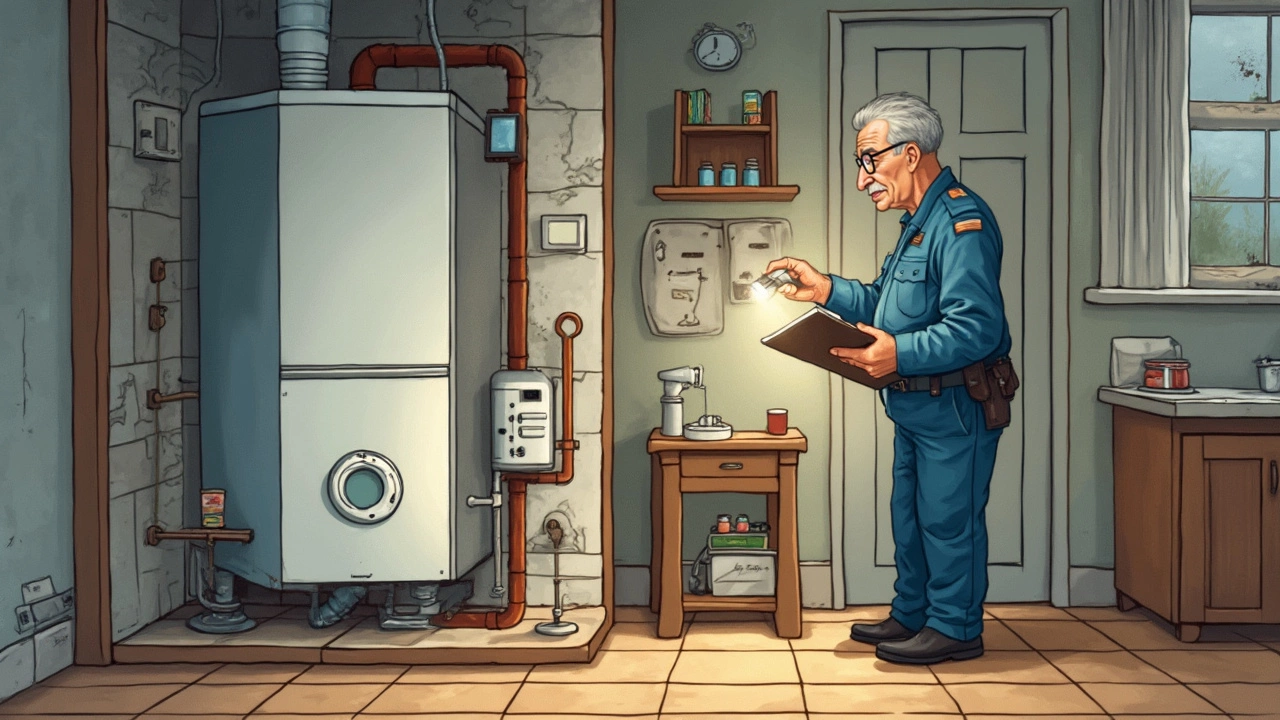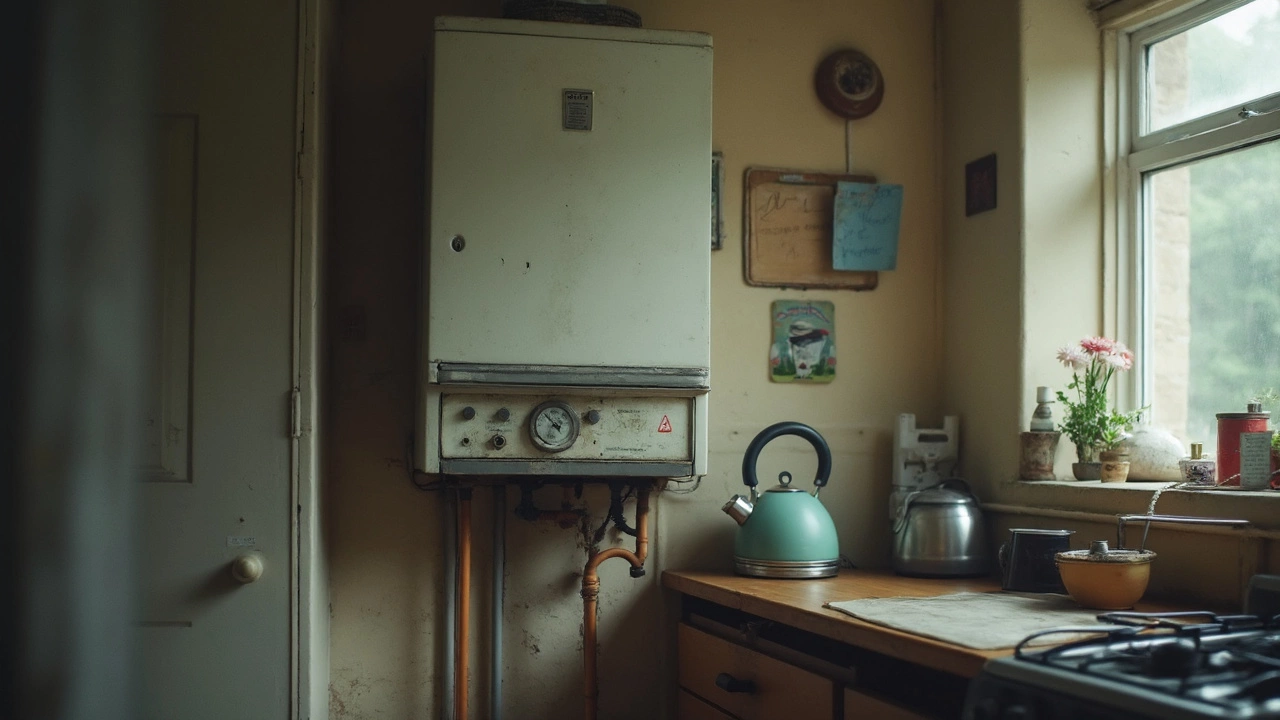A 40-year-old boiler is like driving a car from the 1980s every day—sure, it might run, but is it the best idea? Most people don’t realize how much hidden risk lives inside old heating systems. Boilers don’t just quietly rust away; they can develop leaks, pressure issues, and electrical problems you won’t notice until things get serious.
If you’re still heating your home with a boiler that’s hit the big 4-0, you need to start thinking less about nostalgia and more about safety checks. Gas valves can stick, parts corrode, and controls wear out in ways you can’t always see. Here’s a tip: insurance companies usually won’t give you homeowner’s coverage if your boiler is this old—because they know the risks. Annual servicing is critical, but don’t expect miracles from a machine that’s decades past its prime. Let’s break down what really happens as boilers age, and what steps you can take to keep your home safe and warm without rolling the dice with your family’s safety.
- How Long Do Boilers Really Last?
- Common Safety Risks with Old Boilers
- Signs Your Boiler Might Be Dangerous
- Staying Safe: Maintenance and Checks
- When Should You Replace a Boiler?
How Long Do Boilers Really Last?
Most boilers are built to last 10 to 15 years. Even the best brands rarely make it past 20 without some drama. If you ask a heating engineer, they’ll tell you hitting 20 years is already pushing it for reliability and safety. Forty years? That’s well into overtime.
Old boilers just weren’t designed with today’s materials or technology. Cast iron ones could take a beating, sure, but rust and scale build up inside any boiler with time. That means they lose efficiency, use more fuel, and key parts (like heat exchangers and pumps) just get worn out. The older they get, the harder it is to find parts too. You’ll pay more for repairs or sit through freezing days waiting for an obscure part that’s not made anymore.
If yours is still running after four decades, it’s living proof that some machines just won’t quit—yet that doesn’t mean it’s a good idea to keep running it. No insurance company or gas safety inspector looks at a 40 year old boiler and feels comfortable.
- Average boiler lifespan: 10-15 years
- Major repairs usually are needed after 15-20 years
- Finding replacement parts after 20 years gets tricky (and expensive)
- Old boilers tend to burn more fuel, meaning higher bills
- They’re less safe—parts and safety gear just aren’t as tough as modern units
At the end of the day, a boiler that’s 40 years old is running on borrowed time. The tech has moved on, safety rules have gotten tougher, and nobody designs boilers to go that long anymore.
Common Safety Risks with Old Boilers
Let’s get straight to the point—an old boiler, especially a 40 year old boiler, is risky business. One big reason is corrosion. After decades of heating up and cooling down, parts inside the boiler break down or rust. This messes with the tank and pipework, and once rust eats through, you might face leaks or even worse, a sudden burst that can flood your home or damage your floors.
Next up, old boilers often have worn-down seals and gaskets. These are supposed to stop gas, water, and pressure from escaping. Once they get brittle or cracked, gas leaks can sneak out—sometimes without a smell. That means there’s a risk of carbon monoxide, a colorless, scentless gas that can make you really sick or even kill you. It’s not rare either; emergency services in the UK deal with over 60,000 carbon monoxide incidents every year, and old gas appliances are a big part of that.
Let’s not forget electrical components. Stuff like the control panel, thermostats, and safety shut-offs can fail after years of small surges and wear. Modern features like flame sensors and cut-off switches weren’t even around decades ago, so old boilers often can’t shut themselves off when something goes wrong. That spells double trouble: higher fire risk and more chances of the boiler overheating, which can wreck the system or start a fire.
One more thing—pressure build-up. Old boilers often have blocked or stuck pressure-release valves. These valves need to open up if too much pressure builds inside. If not, there’s a real risk the boiler could explode. This isn’t a horror story; the US Consumer Product Safety Commission reported dozens of cases each year where faulty boilers led to explosions or serious house damage before 1990.
| Risk | Why It Happens |
|---|---|
| Corrosion & Leaks | Decades of water and heat break down metal inside |
| Gas & Carbon Monoxide Leaks | Cracked seals and bad joints let gas escape |
| Electrical Failure | Old parts short out or fail after years of use |
| Explosion & Overheating | Pressure valves stick, boilers can burst |
Most people don’t realize these risks until it’s too late, because problems in an old boiler aren’t always loud and obvious. Staying aware and scheduling regular checks with a pro can help spot weak points before they become disasters.

Signs Your Boiler Might Be Dangerous
If you're hanging on to a 40 year old boiler, there are some red flags you just can’t brush off. Ignoring them isn’t brave—it’s risky. Boilers that old are more likely to break down in ugly ways, and some warning signs are easier to miss than you’d think.
- Unusual noises: Banging, whistling, or gurgling isn’t normal. That rattling noise at 2 a.m.? Usually a sign of kettling (buildup of limescale or sludge) or water pressure issues.
- Strange smells: A musty, metallic, or burning smell near the boiler should set off alarm bells. Gas boilers leaking carbon monoxide often have a slight, odd scent—even though CO itself is odorless.
- Yellow or flickering flame: The burner flame should be strong and blue. A yellow or flickering flame could mean incomplete combustion. That means a risk of carbon monoxide, which is no joke.
- Pilot light keeps going out: If you have to relight the boiler often, something in the safety system or gas supply may be failing. Repeated trips mean trouble.
- Leaks or damp patches: Puddles or random wet spots by the boiler aren’t just annoying—they point to internal corrosion or failing seals. Over time, this can lead to major water damage or pressure drops.
- Electric trips: If the boiler keeps flipping your breaker, it's telling you there's an electrical fault. Safety circuits get jumpy for a reason.
- Rising energy bills: Old boilers lose efficiency fast. If your bills are creeping up year on year, something’s working harder—and probably wearing out in the process.
Here’s some hard truth: in the UK, over 60% of carbon monoxide incidents reported by the Gas Safe Register involve boilers over 15 years old. Multiply that risk by more than double, and you can see why a 40 year old boiler requires real caution.
| Warning Sign | Potential Danger |
|---|---|
| Yellow Flame | Carbon Monoxide Risk |
| Damp/Leaks | Corrosion, Pressure Drops |
| Unusual Smells | Gas Leak, Overheating |
| Pilot Light Issues | Gas Supply Failure |
| Noisy Operation | Limescale Build-up, Faulty Pump |
If you spot any of these signs, don’t wait. Call a registered engineer right away. This isn’t a “wait and see” situation. Playing it safe could save more than just your heating bill.
Staying Safe: Maintenance and Checks
If you’ve got a 40 year old boiler, leaving things to chance just isn’t smart. Old boilers can get unpredictable, so maintenance isn’t just something “nice to do”—it’s essential. Here’s what the experts recommend if you’re still holding onto that vintage heating gear.
The Gas Safe Register is the go-to authority in the UK for gas safety, and they’re clear about regular servicing. As they say:
"An annual boiler service will help keep it operating safely, efficiently and lasting longer... Boilers should only ever be checked or serviced by a Gas Safe registered engineer."
Your yearly boiler check should never be skipped, no matter how steady your old unit seems. Here’s what these maintenance checks should cover:
- Testing all gas and water seals for leaks or signs of corrosion
- Checking pressure valves and safety cut-offs are working right
- Inspecting the flue and ventilation for blockages or rust
- Cleaning the burner and heat exchanger—dust buildup can turn deadly
- Making sure all electrical controls and thermostats are still responding
If you hear weird clunks, see drips, or notice any soot around the boiler, those are warning signs—don’t ignore them. Keep an eye out for carbon monoxide risk as well. A simple carbon monoxide detector, which you can buy for cheap at any hardware store, is a must-have, especially with old boilers. Did you know: According to the NHS, over 200 people in the UK go to hospital each year due to accidental carbon monoxide poisoning—most from faulty heating appliances like old boilers.
| Check Type | Recommended Frequency |
|---|---|
| Full service by Gas Safe engineer | Every 12 months |
| Carbon monoxide detector test | Every month |
| Visual leak & soot check | Every month |
| Pressure gauge check | Every week |
No room for shortcuts here—if an engineer finds anything major, don’t try DIY fixes; these systems mix gas, water, and electrics. The price of a checkup is nothing compared to dealing with a gas leak or worse. Bottom line: scheduled checks and a basic carbon monoxide alarm can keep your old boiler running safer, but know there’s a limit to how long you can stretch its life. If maintenance costs are piling up, that’s a signal it’s probably time for something newer—and safer.

When Should You Replace a Boiler?
There comes a point when squeezing a few more years out of your boiler just isn’t worth the hassle or risk. Most boilers are built to last 10 to 15 years with regular care, and even top-quality models rarely push past 20 without losing safety or performance. If you’re dealing with a 40 year old boiler, you’re operating way past normal life expectancy—and it doesn’t just waste energy, it actually gets riskier each year.
Here’s a quick reality check: by year 20, efficiency, reliability, and safety all start dropping off. Even with annual servicing, parts get harder to find, and the danger of something failing suddenly goes up. Insurance companies and gas-safety professionals draw the line much earlier—many refuse to issue cover after 20 or 25 years.
Watch for these signs telling you it’s time to swap out your old system:
- You notice leaks, strange noises, or pressure drops more than once a year
- The pilot light keeps going out, or the unit struggles to fire up
- Your gas bills are creeping higher without any change in usage
- You’re regularly calling out the engineer for fixes or new parts
- There’s visible rust, corrosion, or water pooling around the unit
- The house feels colder, or heating takes forever
- Safety checks reveal issues, or the boiler fails its annual test
One really useful way to see what you’re up against is to compare boiler lifespans at a glance. Check this out:
| Boiler Type | Average Lifespan (Years) | Common Issues Beyond Typical Lifespan |
|---|---|---|
| Modern Condensing | 10-15 | Heat exchanger leaks, control board failure |
| Older Non-Condensing | 15-20 | Inefficient burners, rust, failing pumps |
| Very Old (Pre-1980s) | 25-30 | Severe corrosion, unsafe emissions |
| Any Boiler Over 40 Years | Rare/Not Recommended | Major safety hazards, parts unavailable |
If you see your boiler in any of the rows with scary warnings, it’s time to plan for a replacement. Sure, it’s a big spend upfront, but a new system slashes your bills, keeps your home safe, and takes stress off your shoulders every winter.
Good rule of thumb? If your engineer hesitates when you ask if it’s still safe, don’t just hope for the best—book that replacement and breathe a whole lot easier.

I am an expert in the services industry with a focus on appliance repair. My passion lies in understanding how things work and educating others in simple, engaging ways. This enthusiasm fuels my writing, where I delve into topics around appliance maintenance and troubleshooting. I aim to make these subjects clear and accessible to all readers.